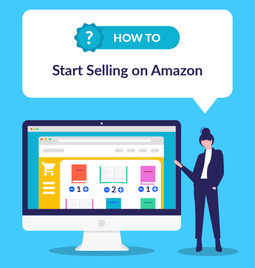How To Sell on Walmart Marketplace in 4 Steps
We may receive a commission from our partners if you click on a link and purchase a product or service on their website. Learn more

Learning how to sell on Walmart Marketplace is a great move for small businesses looking to reach a wider audience on a trusted platform.
However, Walmart doesn’t let just anyone sign up – its application process is known to be stricter than most other online selling platforms.
To help you avoid unnecessary roadblocks when making sales online, I’ll go over the key requirements and break down how to sell on Walmart Marketplace in four steps.
Walmart Marketplace Requirements
Before you can start selling on Walmart Marketplace, your business must meet certain requirements. While this is the same with most marketplaces, Walmart’s application demands are more rigorous than those of other platforms. To get started, you must have:
- A US Business Tax ID or Business License Number – SSNs are not accepted
- Documents verifying your business name and address
- Previous success selling on marketplaces or an ecommerce website
- Products that comply with Walmart’s Prohibited Products Policy
- Products that have GTIN or UPC GS1 Company Prefix Numbers
#1. Register Your Business
If your business meets the above requirements for Walmart Marketplace, head to the account creation page. Fill in your name, basic business information, and Employer Identification Number (EIN). Then, you’ll need to agree to Walmart Marketplace’s terms of service and hit “Create account.”

On the next page, Walmart requests proof of previous selling success, which involves adding a link to your ecommerce store or marketplace.
Your application will then be sent for verification, which can take anywhere between one day and four weeks.
#2. Set Up Payments
Once your account has been verified, you’ll need to register with one of Walmart’s partnered payment processors so you can get paid for any sales you make.
Your payment processor settings are found within your account settings page in the Seller Center, which can be accessed by clicking the small cog icon in the top right corner of the dashboard.
Then, select “Payment info” under the “Financial settings” tab of the sidebar to see your payment processors. In the US, these are:
- Payoneer
- Hyperwallet
- PingPong

Good To Know:
Until Walmart considers you a credible and established seller, you’ll be subject to its new seller payment hold policy, which will delay your payouts for every sale by up to 14 days.You’ll only get out of this hold period once:
- 90 days have passed since your first order was shipped and
- You have made $7,500
#3. Configure Order Fulfilment Settings
You’ll then need to set up shipping and return settings. There are three ways to fulfil orders on Walmart Marketplace:
- Walmart Fulfillment Services: Walmart manages, stores, and ships your products. This is a great option for those looking to use Walmart as a dropshipping supplier.
- Ship yourself: You’re responsible for the entire process.
- Use a third-party shipping provider: Use shipping partner Deliverr or ShipBob to store and ship your items
To set up your shipping option, enter the seller center and click the large “Start shipping” banner at the top of the homepage.
#4. Upload Your Items
With your payment and shipping configured, you’re ready to start selling. To upload your products, head to “Catalog” at the top of the Seller Center sidebar and click the blue “Add items” button.
Bulk Upload
If you already sell on another marketplace or have a large product catalog, you can bulk upload your products.
Under the “Upload a spreadsheet” section, click the “Walmart template” link, which will download a Walmart Marketplace-compatible template. Fill out this template with the information for each product and upload it by clicking the “Browse” button in the dashed box.

Single Item Upload
If your catalog is smaller, you can add your items individually. This is quickest if your item is already listed on Walmart by another seller, which you can check by typing in your product name in the search bar. If it’s not listed, click “Create a new item” and manually input the information.
Final Thoughts
For established small businesses with a track record of completed sales, Walmart Marketplace is a great option to expand your business, since it puts your products on a trusted platform for a wider audience to see. Plus, you’ll have much less competition than other marketplaces because of its lengthy application process.
That said, Walmart Marketplace isn’t suited to new businesses or those looking to start selling immediately due to its high entry requirements and multiple stages of verification. In these cases, a platform like Shopify will be easier – just be prepared to pay a subscription fee, unlike Walmart Marketplace, which only charges a commission when sales are made.



Leave a comment